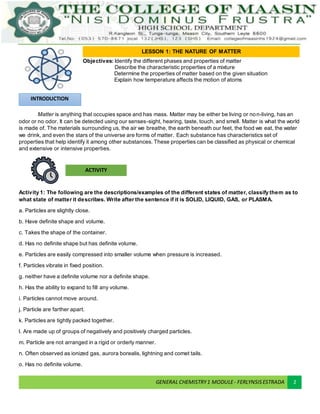Lesson 1 The Nature of Matter
- 1. GENERAL CHEMISTRY1 MODULE- FERLYNSISESTRADA 1 Objectives: Identify the different phases and properties of matter Describe the characteristic properties of a mixture Determine the properties of matter based on the given situation Explain how temperature affects the motion of atoms Matter is anything that occupies space and has mass. Matter may be either be living or non-living, has an odor or no odor. It can be detected using our senses-sight, hearing, taste, touch, and smell. Matter is what the world is made of. The materials surrounding us, the air we breathe, the earth beneath our feet, the food we eat, the water we drink, and even the stars of the universe are forms of matter. Each substance has characteristics set of properties that help identify it among other substances. These properties can be classified as physical or chemical and extensive or intensive properties. Activity 1: The following are the descriptions/examples of the different states of matter, classify them as to what state of matter it describes. Write after the sentence if it is SOLID, LIQUID, GAS, or PLASMA. a. Particles are slightly close. b. Have definite shape and volume. c. Takes the shape of the container. d. Has no definite shape but has definite volume. e. Particles are easily compressed into smaller volume when pressure is increased. f. Particles vibrate in fixed position. g. neither have a definite volume nor a definite shape. h. Has the ability to expand to fill any volume. i. Particles cannot move around. j. Particle are farther apart. k. Particles are tightly packed together. l. Are made up of groups of negatively and positively charged particles. m. Particle are not arranged in a rigid or orderly manner. n. Often observed as ionized gas, aurora borealis, lightning and comet tails. o. Has no definite volume. LESSON 1: THE NATURE OF MATTER INTRODUCTION ACTIVITY
- 2. GENERAL CHEMISTRY1 MODULE- FERLYNSISESTRADA 2 Activity 2 Materials needed: 2 clear glasses, food coloring (liquid or powder) or orange juice, hot water and cold water Procedure: Pour hot water on one glass and cold water on the other glass. Put a food coloring into each glass. Do not stir the mixture! Observe what happen You can also visit this website for better understanding: https://phet.colorado.edu/en/simulation/legacy/states-of- matter. Click the phase of matter that you want to test under change state then adjust the temperature (heat and cool). Observe what happens. Process questions: 1. In which glass of water did the food coloring spread the fastest? Why? ____________________________________________________________________________________________ ____________________________________________________________________________________________ ____________________________________________________________________________________________ ____________________________________________________________________________________________ 2. How does the temperature affect the movement of the particles? ____________________________________________________________________________________________ ____________________________________________________________________________________________ ____________________________________________________________________________________________ ____________________________________________________________________________________________ Activity 3: Perform or analyse the different learning activity below. Then answer the following questions. Learning Activity 1: Measure the length and width of the two pieces of wood (available at home) Learning Activity 2: Tear a paper into four pieces. Burn a piece using the match. Set the burning material on the aluminum pan. Observe what happens to the match and the paper. Learning Activity 3: Mix salt and water. Stir until all salts are dissolved. Process Questions: 1. What are your general observations about the activity? ____________________________________________________________________________________________ ____________________________________________________________________________________________ ____________________________________________________________________________________________ ____________________________________________________________________________________________ 2. Which of the materials remained the same before and after the task was done? Do you think the composition of these materials changed? Why do you say so? ____________________________________________________________________________________________ ____________________________________________________________________________________________ ____________________________________________________________________________________________ ____________________________________________________________________________________________
- 3. GENERAL CHEMISTRY1 MODULE- FERLYNSISESTRADA 3 3. Which materials changed after the activity? Do you think the composition of these materials changed? Why do you say so? ____________________________________________________________________________________________ ____________________________________________________________________________________________ ____________________________________________________________________________________________ ____________________________________________________________________________________________ 4. Which observations can you classify as physical properties? Which are chemical properties? ____________________________________________________________________________________________ ____________________________________________________________________________________________ ____________________________________________________________________________________________ ____________________________________________________________________________________________ Activity 4: Give the definition of physical and chemical property by analysing the example below.Write your answer on the space provided. ___________________________________________ ___________________________________________ ___________________________________________ ___________________________________________ ___________________________________________ ___________________________________________ ___________________________________________ ___________________________________________ ___________________________________________ Activity 5: Give the definition of intensive and extensive property by analysing the example below. Write your answer on the space provided. ___________________________________________ ___________________________________________ ___________________________________________ ___________________________________________ ___________________________________________ ___________________________________________ ___________________________________________ ___________________________________________ ___________________________________________ ___________________________________________ ___________________________________________
- 4. GENERAL CHEMISTRY1 MODULE- FERLYNSISESTRADA 4 Activity 6: Classify each of the following statements as describing a physical or a chemical property, and explain the basis for your answers. Statements Property Explanation Chlorine is a greenish-yellow gas at room temperature. Liquid oxygen is attracted to a magnet. Gold is highly resistant to corrosion. Light objects float on very salty water. Sugar is a high-energy food. Activity 7: Describe the different properties of matter using the graphic organizer below. Physical Chemical Extensive Intensive EXERCISES Properties of Matter
- 5. GENERAL CHEMISTRY1 MODULE- FERLYNSISESTRADA 5 Activity 8: Classify the following changes ofmatter as Physical or Chemical Statements Physical or Chemical You cut your hair Mixing sugar and water Making a peanut, pretzel and cerealmixture Baking soda reacts with vinegar and forms a gas A piece of metal is bent in half Methanol is burned and leaves a residue An aspirin is crushed into fine powder Copper turns green when exposed to the environment Two clear liquids are mixed and a yellow color forms Baking cookies Diamonds are used to scratch glass A tree burns to form ashes A piece of paper is crumpled up Water freezes to form ice A candle burns Leaves change colors in the fall A car rusts A pencil is sharpened A cup of water evaporates (to be filled up by the students) ____________________________________________________________________________________________ ____________________________________________________________________________________________ ____________________________________________________________________________________________ ____________________________________________________________________________________________ ____________________________________________________________________________________________ ____________________________________________________________________________________________ ____________________________________________________________________________________________ ____________________________________________________________________________________________ https://phet.colorado.edu/en/simulation/legacy/states-of-matter Bayquen A., Pena G., General Chemistry 1 2016 FEEDBACK RESOURCE ASSESSMENT





